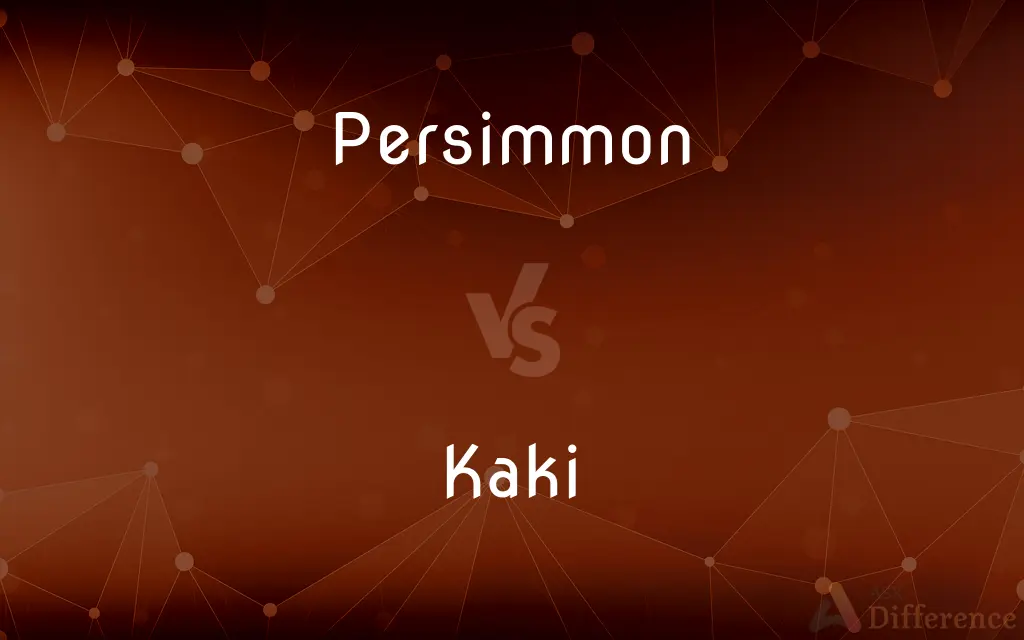Persimmon vs. Kaki — What's the Difference?
By Tayyaba Rehman & Urooj Arif — Updated on April 28, 2024
Persimmon generally refers to the fruit from a variety of species within the genus Diospyros, whereas "kaki" specifically denotes the Asian persimmon, Diospyros kaki, known for its sweet, orange fruit.

Difference Between Persimmon and Kaki
Table of Contents
ADVERTISEMENT
Key Differences
Persimmons are fruits from the Diospyros genus, which includes several species producing edible fruit, such as the American persimmon (Diospyros virginiana) and the black persimmon (Diospyros texana). Kaki, on the other hand, specifically refers to the Asian persimmon, Diospyros kaki.
In persimmons, these fruits vary widely in size, flavor, and texture, depending on the species and region where they grow. And kaki which is native to East Asia and widely cultivated for its large, sweet fruit that can be eaten fresh, dried, or cooked.
While "persimmon" might be used to describe any fruit from the Diospyros genus globally, "kaki" is often used interchangeably with "Asian persimmon" in markets and culinary contexts to specifically identify this variety.
Kakis are particularly noted for their vibrant orange color and can be categorized into astringent and non-astringent types, which refer to the presence of soluble tannins that affect the fruit’s taste and texture. In contrast, American persimmons are typically smaller, with a richer, honey-like flavor, and are usually consumed only after they've fully ripened and softened.
Comparison Chart
Species Variety
Includes several species like D. virginiana.
Primarily refers to Diospyros kaki.
ADVERTISEMENT
Geographic Origin
Various, including North America and Asia.
Native to East Asia.
Taste and Texture
Varies by species; can be astringent or sweet.
Typically sweet; available in astringent and non-astringent varieties.
Usage
Fresh, cooked, or dried.
Commonly eaten fresh, dried, or in traditional dishes.
Cultural Significance
Various uses and significance in local cultures.
Important in East Asian cuisine and culture.
Compare with Definitions
Persimmon
Cultivated and wild varieties are available.
Wild persimmons are smaller but have a deep flavor.
Kaki
Eaten fresh, dried, or used in desserts.
Persimmon pudding made from kaki is a traditional dessert.
Persimmon
Can be astringent or non-astringent depending on the species.
I avoid eating persimmons until they're fully ripe because of their astringency.
Kaki
Integral to cultural practices and cuisine in East Asia.
Kaki fruits are often given as gifts during special occasions in Asia.
Persimmon
Used in various culinary and traditional medicines.
Persimmons are used in traditional remedies for their health benefits.
Kaki
Diospyros kaki, known for its large, sweet orange fruits.
The kaki fruits from my local market are incredibly juicy and sweet.
Persimmon
Fruit of the Diospyros genus, varying widely in flavor and size.
The persimmon tree in my backyard yields very sweet fruit.
Kaki
Popular in East Asia, cultivated widely.
In Japan, kaki fruits are a common sight at markets during the autumn.
Persimmon
Consumed fresh, dried, or in recipes.
Dried persimmon is a healthy snack that's packed with vitamins.
Kaki
Available in both astringent and non-astringent forms.
I prefer non-astringent kaki because they can be eaten while still firm.
Persimmon
The persimmon is the edible fruit of a number of species of trees in the genus Diospyros. The most widely cultivated of these is the Oriental persimmon, Diospyros kaki.
Kaki
A tree (Diospyros kaki) native to China, widely cultivated for its large edible fruit, having orange to reddish skin, orange flesh, and an enlarged, persistent calyx.
Persimmon
Any of various chiefly tropical trees of the genus Diospyros, having hard wood and orange-red fruit with sweet usually soft pulp, especially D. kaki, native to East Asia, and D. virginiana, native to the eastern United States.
Kaki
The fruit of this tree. In both senses also called Japanese persimmon.
Persimmon
The fruit of any of these trees.
Kaki
A persimmon, more specifically the Japanese persimmon (Diospyros kaki).
Persimmon
A type of fruit, of orange colour, very sweet, quite astringent when immature.
Kaki
Small deciduous Asiatic tree bearing large red or orange edible astringent fruit
Persimmon
The tree this fruit grows on, generally one of two species of ebony: Diospyros kaki (Asian) or Diospyros virginiana (North American).
Kaki
Blackish stilt of New Zealand sometimes considered a color phase of the white-headed stilt
Persimmon
An American tree (Diospyros Virginiana) and its fruit, found from New York southward. The fruit is like a plum in appearance, but is very harsh and astringent until it has been exposed to frost, when it becomes palatable and nutritious.
Persimmon
Any of several tropical trees of the genus Diospyros
Persimmon
Orange fruit resembling a plum; edible when fully ripe
Common Curiosities
Are all kaki fruits non-astringent?
No, kaki fruits come in both astringent and non-astringent varieties, with astringency decreasing as the fruit ripens or after treatment.
What are the health benefits of consuming kaki?
Kaki fruits are rich in vitamins, especially vitamin A and C, and contain antioxidants that can help improve eye health and reduce inflammation.
What is the main difference in taste between persimmon and kaki?
Persimmons can range from sweet to astringent depending on the variety and ripeness, whereas kaki, specifically the non-astringent variety, is consistently sweet and mild.
Can persimmon and kaki be used interchangeably in recipes?
While they can sometimes be substituted for each other, the specific texture and sweetness of kaki make it more suitable for certain dishes, especially desserts.
Can you cook with both persimmon and kaki?
Yes, both can be used in cooking, though their usage might differ based on their texture and sweetness; kaki is commonly used in desserts in East Asia.
Are persimmons available year-round?
Persimmons are typically seasonal, available mainly in the fall and early winter, though availability can vary based on local climate and specific species.
What is a common mistake people make when eating astringent persimmons?
A common mistake is eating astringent persimmons before they are fully ripe, which can lead to an unpleasantly bitter and puckering taste.
How do you know when a persimmon is ripe enough to eat?
Persimmons are typically ripe when they feel soft to the touch; for astringent varieties, it is essential to wait until they are fully ripe to avoid bitterness.
Why are kaki fruits popular in traditional East Asian medicine?
In traditional East Asian medicine, kaki fruits are used for their supposed benefits in improving digestion, boosting immunity, and helping to relieve hypertension.
What makes kaki different from other persimmon species in terms of cultivation?
Kaki is specifically bred and cultivated for its larger size and consistent flavor profile, making it highly popular and commercially significant in East Asia.
Share Your Discovery

Previous Comparison
Stamp vs. Affix
Next Comparison
Soho vs. BohoAuthor Spotlight
Written by
Tayyaba RehmanTayyaba Rehman is a distinguished writer, currently serving as a primary contributor to askdifference.com. As a researcher in semantics and etymology, Tayyaba's passion for the complexity of languages and their distinctions has found a perfect home on the platform. Tayyaba delves into the intricacies of language, distinguishing between commonly confused words and phrases, thereby providing clarity for readers worldwide.
Co-written by
Urooj ArifUrooj is a skilled content writer at Ask Difference, known for her exceptional ability to simplify complex topics into engaging and informative content. With a passion for research and a flair for clear, concise writing, she consistently delivers articles that resonate with our diverse audience.
















































